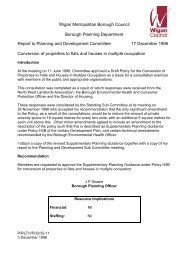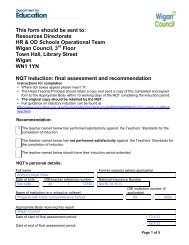Level 2 Strategic Flood Risk Assessment (.pdf ... - Wigan Council
Level 2 Strategic Flood Risk Assessment (.pdf ... - Wigan Council
Level 2 Strategic Flood Risk Assessment (.pdf ... - Wigan Council
Create successful ePaper yourself
Turn your PDF publications into a flip-book with our unique Google optimized e-Paper software.
9 Outline Mitigation OptionsChapter 9 proposes an outline mitigation strategy by highlighting the mitigation measuresthat should be considered in accordance with PPS25.9.1 IntroductionThere are a range of planning considerations and mitigation strategies available for flood risk,outlined below. In addition, a "flood risk balance sheet" (Appendix B) has been prepared,which is designed to facilitate the Exception Test and demonstrate the acceptability andsoundness of the proposed development sites.9.2 Planning considerations9.2.1 Site layout and design<strong>Flood</strong> risk should be considered at an early stage in deciding the layout and design of a siteto provide an opportunity to reduce flood risk within the development.The PPS25 Practice Guide states that a sequential, risk-based approach should be applied totry to locate more vulnerable land use to higher ground, while more flood-compatibledevelopment (e.g. car parking, recreational space) can be located in higher risk areas.Waterside areas, or areas along known flow routes, can be used for recreation, amenity andenvironmental purposes, allowing the preservation of flow routes and flood storage, and atthe same time providing valuable social and environmental benefits contributing to othersustainability objectives. Landscaping should ensure safe access to higher ground fromthese areas and avoid the creation of isolated islands as water levels rise.9.2.2 Modification of ground levelsModifying ground levels to raise the land above the required flood level is a very effective wayof reducing flood risk to the site in question.However, in most areas of fluvial flood risk, floodplain volume would be reduced by raisingland above the floodplain, often adversely affecting flood risk in the vicinity and downstream.Compensatory flood storage must be provided, and should be on a level for level, volume forvolume basis on land that does not currently flood but is adjacent to the floodplain (in orderfor it to fill and drain). It should be in the vicinity of the site and within the red line of theplanning application boundary (unless the site is strategically allocated) and based on a levelfor level compensation for any loss of floodplain.Where the site is entirely within the floodplain it is not possible to provide compensatorystorage at the maximum flood level and this will not be a viable mitigation option.Compensation schemes must be environmentally sound.9.2.3 Local flood storageWhere development reduces the volume of floodplain storage it will be necessary to providecompensatory storage locally. This could be an environmental wetland area, designatedwashland (designed to flood) or a flood basin. This can also be considered within urbandesign if areas are designated to flood in a flood event (e.g. ground floor of a developmentwith residential on first floor).On a strategic catchment-wide scale, appropriately located flood storage basins andwashlands can not only provide a reduction in flood risk, but can also enhance and contributeto wetland restoration and habitat creation, as well as potentially increasing the recreationalvalue of many river corridors. For upstream flood storage schemes to maximise benefitsdownstream, they need to be located in suitable areas of the catchment. Locating floodstorage basins too high in the catchment could mean that a large proportion of a flood eventis still able to travel downstream from other areas in the catchment.2009s0578 Final SFRA with Environment Agency Comments - L2 Ver5 <strong>Wigan</strong>.doc 40
















